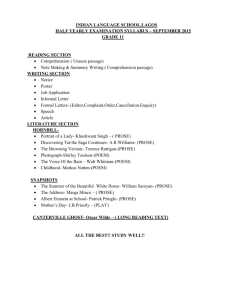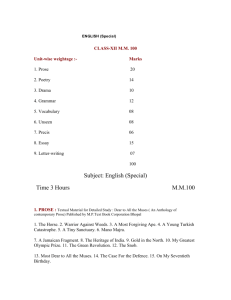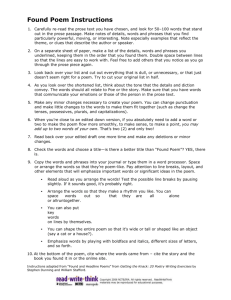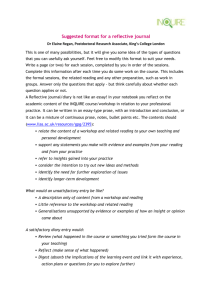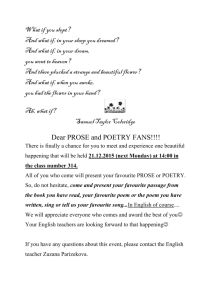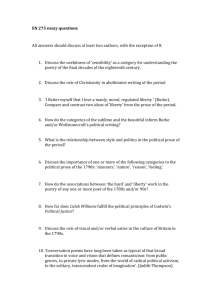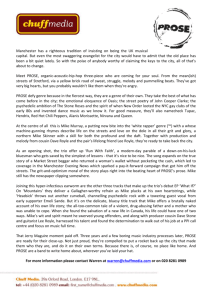Better than Text
advertisement
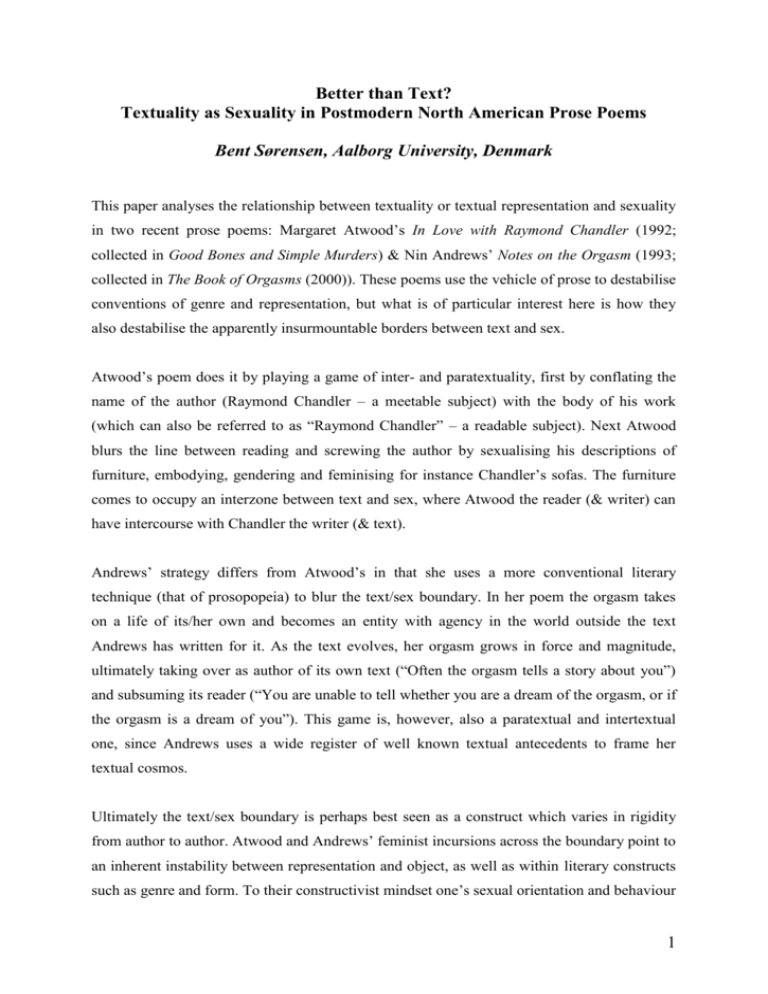
Better than Text? Textuality as Sexuality in Postmodern North American Prose Poems Bent Sørensen, Aalborg University, Denmark This paper analyses the relationship between textuality or textual representation and sexuality in two recent prose poems: Margaret Atwood’s In Love with Raymond Chandler (1992; collected in Good Bones and Simple Murders) & Nin Andrews’ Notes on the Orgasm (1993; collected in The Book of Orgasms (2000)). These poems use the vehicle of prose to destabilise conventions of genre and representation, but what is of particular interest here is how they also destabilise the apparently insurmountable borders between text and sex. Atwood’s poem does it by playing a game of inter- and paratextuality, first by conflating the name of the author (Raymond Chandler – a meetable subject) with the body of his work (which can also be referred to as “Raymond Chandler” – a readable subject). Next Atwood blurs the line between reading and screwing the author by sexualising his descriptions of furniture, embodying, gendering and feminising for instance Chandler’s sofas. The furniture comes to occupy an interzone between text and sex, where Atwood the reader (& writer) can have intercourse with Chandler the writer (& text). Andrews’ strategy differs from Atwood’s in that she uses a more conventional literary technique (that of prosopopeia) to blur the text/sex boundary. In her poem the orgasm takes on a life of its/her own and becomes an entity with agency in the world outside the text Andrews has written for it. As the text evolves, her orgasm grows in force and magnitude, ultimately taking over as author of its own text (“Often the orgasm tells a story about you”) and subsuming its reader (“You are unable to tell whether you are a dream of the orgasm, or if the orgasm is a dream of you”). This game is, however, also a paratextual and intertextual one, since Andrews uses a wide register of well known textual antecedents to frame her textual cosmos. Ultimately the text/sex boundary is perhaps best seen as a construct which varies in rigidity from author to author. Atwood and Andrews’ feminist incursions across the boundary point to an inherent instability between representation and object, as well as within literary constructs such as genre and form. To their constructivist mindset one’s sexual orientation and behaviour 1 is contingent on many external factors, and not an essential, innate or inherent part of one’s identity. Once sex and sexuality is regarded as constructed, the road is open for a conflation of sexual and textual identities, as a comparison of constructs or even as a test of identity positions via a negotiation between potential constructs. Thus identity becomes authored much like texts do. Text is thus often conflated with sex, and even if we were to maintain a tenuous distinction between them, there is a tendency, for postmodern writers and critics alike, to ultimately think that there is no reason why sexual intercourse should be better than textual intercourse. The prose poem The prose poem is a genre which often is regarded with suspicion, and seen as a mongrel form consisting of short descriptive prose passages, often uncertainly perched between fiction and creative non-fiction (such as the essay), and yet featuring a marked use of effects of language more common to poetry than to prose, such as hypertrophied metaphors. Here I would propose that the prose poem be regarded as a more positive construct, accommodating as it is to multiple generic influences, yet forming a unique modality of expression in its own right. In his recent collection, Great American Prose Poems from Poe to the Present (2003) – where incidentally both pieces dealt with in this paper are included – the editor, David Lehman, writes: “The prose poem is a hybrid form, an anomaly if not a paradox or an oxymoron.” The oxymoronic nature of the genre lies in its making us pose questions such as these: How can the prose poem be a poem if it is prose, and how can a prose poem be a piece of prose if it is a poem? The answers tend to teeter between banality and paradoxical obscurity. One way out of the anomaly of a genre resisting definition is to be what one might term meta-formalistic in one’s approach. Such a meta-formalistic claim might run: In prose poems we have a sequence of competing unifying frames where two genre labels compete: the text is a poetic expression, and yet this expression turns out to be “framed” by the status of the text being in prose. These unifying frames then clash further with subversive meta-frames, such as fragmentariness or incompletion, which could be argued to constitute the prose poem in general. (This reflects a suspicion against brevity which is usually marshalled against prose pieces, but which is not as aggressively present against poetry where brevity is seen as legitimate and not as an indication of incompleteness.) 2 Sometimes the genre offers definitions that read as meta-prose poems in their own right: When Charles Simic writes: “The prose poem is a result of two contradictory impulses, prose and poetry, and therefore cannot exist, but it does”, and “The prose poem is a burst of language following a collision with a large piece of furniture” he establishes a tension between defining the genre and surrendering to the paradoxicality of its constraints. In a gesture simultaneously celebratory and frustrated, Louis Jenkins throws up his hands with the comment: “Heck, one can call most anything a prose poem. That’s what’s great about them, anything that’s not something else is probably a prose poem”. This strategy is not metaformalistic but poetic, and typically is the choice of the practitioners of the genre themselves. Echoes of these meta-lyrical definitions also surface in prose poems that are not definitory as their primary aim, but still meta-texts, as for instance Andrews’ and Atwood’s pieces are in their investigation of text and representation. In the following I proceed in the lyrical spirit of Jenkins, but with a slightly more formalistic insistence on certain features being present in the texts I analyse for me to include them in the canon of anomalies and paradoxes. I aim to show that both Atwood and Andrews deliberately play with generic conventions to construct the slippages of meaning between textuality and sexuality, and that it requires a paradoxical and hybrid form such as the prose poem to achieve the uncertainty of interpretation that precisely lets the reader penetrate the text/sex boundary when reading these pieces. Intertextual and paratextual bodies In Atwood’s piece “In Love with Raymond Chandler” the game of intert/sex(t)uality is the most obvious angle to approach the text from. The reader is invited to enjoy celebrating his or her shared familiarity with Raymond Chandler. Since most of us are less familiar with the person Raymond Chandler than with the corpus of work also known by that name, our expectations are immediately challenged by the first line of Atwood’s piece which invites us to imagine: “An affair with Raymond Chandler, what a joy!” We imagine Chandler’s body in various intimate situations and positions, and speculate on the nature of the joy involved in joining up with this body. However, we soon begin to feel the ground slipping beneath our fantasy when we continue to hear about “the mangled bodies and the marinated cops and hints of eccentric sex” which in the next sentence becomes the catalogue of reasons not causing the 3 joy of the affair. These are obviously not features of the body of Chandler the man, but rather well known literary features of the man’s body of work. Thus the first lyrical instance in Atwood’s text manifests itself: the two bodies or corpora are conflated. The access to Chandler’s physical body – the one we imagine the affair with – is mediated through a reading and discarding of large elements of his textual body, and thus the bodies metaphorically stand for one another. Since it is not the already mentioned features of Chandler’s literary corpus that turns the writer/reader of the piece on, but rather the way Chandler (the writer) has with furniture, we are ready for a further exploration of textual pleasure in Chandler via Atwood’s metaphors and similes: “He knew that furniture could breathe, could feel, not as we do but in a way more muffled, like the word upholstery with its overtones of mustiness and dust, its bouquet of sunlight on aging cloth”. The animation (through the figure of prosopopeia) of the furniture in Chandler’s textual body opens the only viable way towards textual intercourse with the real body of Chandler. The textures of upholstery are lyricised much as we have come to expect the skin of humans to be in more conventional love lyrics, being endowed as they are with sensory impressions titillating both our sense of smell and of sight/taste (since bouquet is ambiguous in its sensory corollary it suggests a process of synaesthesia, as much Romantic love poetry does). The sofas in particular are feminised by Atwood’s reanimation of Chandler’s prose descriptions of these furnishings: “stuffed to roundness, satin-covered, pale blue like the eyes of his cold blond unbodied murderous women”. The role of Atwood’s first person persona, who desires these sofas as much as Chandler’s gaze and pen is suggested to do, is ambiguous in its sexual orientation: “Only after we had sniffed, fingered, rubbed, rolled on and absorbed the furniture of the room would we fall into each other’s arms”. The active part of Atwood’s probing persona suggests that far from being the passive reader of Chandler’s phantasmagoria of sexualised furniture, Atwood’s reader is as active in this “affair” as Chandler himself, inscribing her own probings on the furniture, sexualising the sofa-texts in equal measure with the original inscription of them in Chandler’s text. In the coda, the merger of bodies of text and of flesh is completed. The two subjects, Atwood’s reader and re-inscriber are finally ready to meet the subject of Chandler the man in a non-mediated intercourse: “ready at last to do the same things to each other”. But this 4 consummation is left dangling and untold, as these are the last words of the piece. This suggests that the textual intercourse which has already taken place in the poem, and which is fully unfolded in long lists of objects described in lyrical, heightened adjective driven language (viz. “the rich abstract scent of the oval transparent soaps”), is far more important than the postulated sexual intercourse one might imagine having with Chandler’s physical body. Since that hypothetical intercourse can only take place in a frame that is culled from and constitute a re-inscription of Chandler’s textual space, it remains far more fictional than the purely textual pleasure so elaborately spelled out in the body of the poem. Although Atwood’s piece has formal similarities with a short prose piece, there are few traces of a plot in it. Rather the text is a lyrical meditation on how rooms and furnishings manifest themselves in one writer’s language, and how another writer’s language together with a reader’s imagination can sexualise this space. Atwood’s prose poem is thus quite literally an illustration of Simic’s metaphorical definition of the genre as “a burst of language following a collision with a large piece of furniture”. The bodies of sofas, Raymond Chandler, and his novels not only collide with, but also have intercourse with the bodies of Atwood, her language, and at least the charged mind of her readers. Prosopopeia and orgasms Andrews’ Notes on the Orgasm looks like a cross between a brief list (as witnessed by the title element “Notes”) and a 14 stanza lyrical poem. It thus features formal characteristics that are far less prose narrative-like than the apparent markers of narrative of Atwood’s piece. Andrews’ poem looks like a poem, in that it appears to have a stanza-like structure, or at least only marginally a paragraph structure, since almost all 14 sections are quite short. Of the piece’s other lyric-like features one might also mention its repetitive nature, which manifests itself literally as most stanzas begin with the words “The orgasm”, and also on a dialogical level, as most stanzas have a call-response structure, which in terms of content is structured as a claim-argument structure: Claim: “The orgasm will peel you like an orange.” Why? “The orgasm wants you to live life without the rind”. The listiness of Andrews’ piece, while on the surface of things seeming to marshal a nonfiction reading protocol, actually accentuates its lyrical nature. Although the orgasm functions as the piece’s protagonist, the personified orgasm is soon seen to transcend the role usually 5 allotted to protagonists of prose narratives. Rather the orgasm is revealed, through the litany listing its ever more potent qualities, to be a metaphor for the cosmic insight we more conventionally associate with religious ecstasy or spiritual enlightenment. The orgasm is therefore an aspect of God (“The orgasm says we are all parts of herself”), or in a textual universe, takes on the qualities of the writer: “The orgasm tells you many stories. […] Such beautiful lies. You want them all. Why would you need truth when you can have an orgasm?” Thus, this orgasm originates in textuality, as a number of claims are made by the poem about the nature of the orgasm. However, the orgasm loops paradoxically back on itself, and outgrows the limits of being inscribed in a text. Rather, the orgasm performs inscriptions of its own, much as Atwood’s persona did on/to Chandler’s furniture and ultimately Chandler himself. In Andrews’ case there is no named intertext, and only the references to storytelling and plot strands from pulp fictions of crime and seduction (“She waits for you on street corners and follows you down dark alleys, softly, her hands passing continually over your hair, caressing your bare shoulders”) are echoes of the noir genre, incidentally the very one that Chandler represents so archetypically. The game played with the reader in Andrews’ poem is less overtly paratextual too, since the poem’s title can be taken at face value at least in the early part of the reading, as literally a text consisting of a list of notes, fragmentarily brought together to characterise the orgasm. However, the presence of a whole entity, titled The Book of Orgasms, of which the list poem is only one small part, destabilises that non-fictional reading protocol, and rather evokes the same associations as mentioned before of the text inscribing itself in a religious register where other books such as The Book of Job, or The Book of Proverbs belongs. The generic hybrid of Andrews’ text is thus hardly less intriguing than that of Atwood. Andrews draws on a register of both biblical and pulp fictional associations, once one reads past the dull non-fiction register of notes and lists. Her orgasm is ultimately a cosmic text and author all rolled into one, seducing us as well as using us as “launching pads” for her larger scheme of “fucking angels”. Andrews’ orgasm suggests at first that it transcends text, but as it grows in scope it casually subsumes the body of its author as well as a full-blown textual universe of stories. Yet it is ultimately trapped in its own book of orgasms, and cannot be accessed by us other than through the text of itself. 6 This duality of the orgasm’s transcendence and its ineluctable textuality is exactly Andrews’ strategy of blurring the text/sex boundary. The metaphoricity of the orgasm is that it is the creative principle, but also the power base that all creativity needs in order to transmit itself to others. Without that power the text may well be text, but it may also remain unread. Andrews is no Emily Dickinson, meekly resigned to the fate of concealing a cosmos in her desk drawer, only to be rescued from obscurity by a fluke. She flaunts her orgasms, and thereby her textuality, encouraging us as readers to re-experience them/it every time we read her poems. Better than text? Is sex then better than text, as I seemed to suggest in my title? That the question is poorly and crudely formulated is witnessed by the subtle textual strategies of these two authors and their run-away machines of worldly/wordly seductions and orgasms. Sex is text, just as text is sex in these prose poems. The genre lends itself particularly well to those slippages of meaning often utilised by feminist writers who thrive on reversals, writing back to, and the subverting of reified generic and thematic conventions. Thus we may suggest that the masculine one-upmanship of intertextual games is critiqued by Atwood, who throughout her book of Bones & Murder wreaks havoc with the conventions of the detective game, which is perhaps the most intertextual and epistemological, and in its hard-boiled version, most masculine of all genres. In Andrews’ orgasm poems we see an innovative use of the most moribund of all Romantic figures, that of prosopopeia, which is dislodged from its stale place among amateur writer’s favourite ways of being ‘lyrical’ by Andrews’ in-your-face orgasm’s labiality. The ability of these pieces to transcend boundaries of genre, blending narrativity and lyricism, as well as questioning our inherent desire to see language as representation shows that the prose poem is a potent hybrid for sexing up texts, as well as texting up sex. References Andrews, Nin: The Book of Orgasms, Bloodaxe Books, Northumberland (2000/2003) Atwood, Margaret: Bones & Murder, Virago Press, London. (1992/1995), portions of which were published originally as Good Bones, Toronto (1992), and reissued as Good Bones & Simple Murders, Nan E. Talese (2001) Lehman, David: Great American Prose Poems: From Poe to the Present, Scribner Book Company, New York (2003) 7
